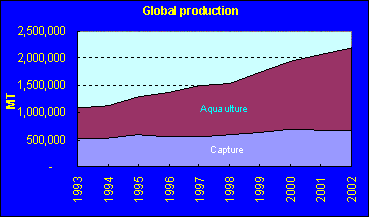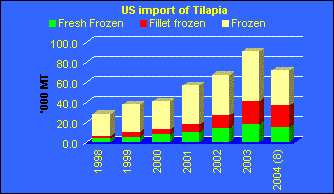The Beginning
Seafood industry is one among the ancient businesses around the world. But of late certain burning issues in over-fishing has put a premium on commercial fishing operations while the debate on environmental and ecological hazards of the industry and some of the contentious fishing methods have triggered an unprecedented backlash in the global market.
In spite of strict guidelines and regulations put into place to check these menaces, the industry has felt a strong need to explore other environment-friendly aquaculture possibilities.
And the concept of cultivable fish was born. Salmon, cod, haddock and many other species were found to be suitable for cultivation in aquaculture environment.

This concept of seafood farming grew considerably and the industry was put back on its tracks. But not before other concerning factors loomed large before the industry - the cost involved in seafood farming and the consequent environmentally degradable fallouts it produced.
Say for instance, sea farming of fishes like salmon and cod demands open-sea cages and use large amount of supplementary feed that is mainly produced from fish. And most cultivable fishes require a higher level of dissolved oxygen for their survival.
To address these issues and the evading solutions the industry employed extensive research into environment-friendly aquaculture possibilities. The subsequent studies conducted, glimmered a ray of hope in Tilapia aquaculture.
The research unveiled new prospects of a much-neglected fish called Tilapia and its environment-friendly farming capabilities. Unlike other sea-farmed fishes, Tilapia is comparatively environment friendly as it can convert natural food organisms to flesh and its farms use land based enclosed systems.
Historical Background
In 1940's Tilapia was introduced in many Asian countries from its native south central Africa. The decade between 1960 and 1970 saw Tilapia culture redirected towards the production of food for local consumption and for the inflation of rural activities related to agriculture and animal husbandry.
The farming became soon unprofitable due its excessive breeding and related overcrowding and stunted growth. However, husbandry techniques developed in last two decades including all male culture, hybridization, and grow out systems yielding uniform large size fishes, revived the industry.
The Species
There are four major species of Tilapia used in aquaculture Species most often cultured are Nile Tilapia Red Tilapia, Mozambique Tilapia and their hybrids.
The species of the Genus Oreochromis are maternal mouth brooders and exhibit parental care. Under fast growing conditions they attain maturity in three months at a weight of 60 to 100 gm.
Why Tilapia?
Tilapia are more resistant to viral, Bacteriological and fungal diseases than other aquaculture species and tolerate wide range of salinity. They prefer water temperatures between 29 and 31C. Growth rates decline rapidly at temperatures below 20C. Inability of tilapia to tolerate low temperatures is a serious constraint for commercial culture in temperate regions.
They can tolerate lower levels of dissolved oxygen (DO) concentrations less than 0.5 mg/l, which is apparently below the tolerance levels for most cultivable fishes. Tilapia consumes a wide variety of food including plankton, green leaves, benthic organisms, aquatic invertebrates, larval fish, and detritus and decomposing organic matter.
Tilapias have very low fecundity but mature fast and are prolific in breeding thus causing overcrowding and stunted growth in mixed culture practices. Cage culture prevents overcrowding, as the females cannot recover the eggs for oral incubation.
All male culture prevents spawning and also gives better yield as the males grows faster. All male fingerlings are produced using sex reversal techniques or by manually separating sexes. Males in general demonstrate a growth rate 40% faster than that of females.
It takes about 8-10 months to bring tilapia to a marketable size, compared to 2-3 years for salmon. The ideal market size is 400 to 500g (8 to 10 months) for whole fish and 700 to 1000g (11 to 14 months old) for production of processed fillets.
Homes of Tilapia
Major Tilapia producing countries are located in Asia with Latin American countries fast emerging on the front. China, Philippines, Taiwan and Indonesia and Thailand together produced about 1,100 thousand metric tonnes of Tilapia in 2001, constituting about 76% of total aquaculture production of Tilapia.
Tilapia culture in Latin America is relatively new and the aquaculture production from Brazil, Costa Rica, Mexico and Columbia together grew from 18,000 in'93 to 80,000 metric tonnes in 2001.
And according to the literature, World Tilapia Farming 2002 by Cesar C. Alceste and Darryl E. Jory, Tilapia is becoming a competitor for traditional white fish species.
Evolution of Trade
The global production of the Tilapia doubled over last 10 years mainly due to growth in aquaculture activities. The global trade According to FAO statistics grew four fold in quantity and about 6.5 fold in value.
The U.S imported about 96% of the global supply to the international market. The major suppler to the international arena is Taiwan, according to the FAO statistics.
However, the actual trade may be much higher than the projected figures as the Taiwan Province of China and the U.S are the only countries, which have recorded Tilapia separately in their trade statistics.
The U.S Market
According to NMFS statistics Tilapia and its products stood 6th in total U.S edible seafood import quantity since 2001.The percentage composition of tilapia to total edible seafood import increased from 3.2% in 2001 to 4.3% in 2003. Tilapia rank second only to Atlantic salmon among cultured fish species. Percentage contribution of farmed Atlantic salmon products seems to be stagnated at around 8% during the last three-year period.
Tilapia - Growing Imports
While the unit price of most of the seafood products imported to the U.S either stagnated or declined over the last three year period, the price of tilapia and its product increased by 18% almost equaling to prices of tuna.
The import of tilapia to the U.S increased from 27.8 thousand metric tonnes ($52.7 Million) in 1998 to 90.2 thousand metric tonnes ($241.2 million) in 2003. The corresponding values for 2002 were 67 thousand metric tones and $174 million.
And in 2004, Up to August the U.S imported 71.2 thousand metric metric tonnes worth U.S $191.2 million.
China ranked first in total tilapia products during 2002 overtaking Taipei China and in 2003 China constituted 50% of the import quantity to the U.S. Over 90% of the frozen tilapia products came from China and Taipei while 75% of the fresh tilapia fillets were from Ecuador and Costa Rica.
Since 1996 the U.S domestic production of Tilapia including both aquaculture and capture hovers around 20,000 metric tonnes. According to Agriculture Marketing Resource center (AMRC) Iowa state university almost all U.S production of Tilapia is marketed live.
The Fresh price in the U.S market has increased indicating strong demand for the products. Frozen products prices are stagnated at 2001 levels but declined in 2003.

The European Market
Apart from the U.S there is considerable interest for Tilapia in Europe as an inexpensive substitute for white fish fillet. Analysis of specie-wise export statistics of Taiwan has shown that the export to E.U has increased from 4.6 thousand MT ($5.8 million) in 2000 to 7.9 thousand MT (($10.4 million) in 2002. The export to the E.U during 2003 however declined to 5.9 thousand MT ($8.9 million).
During 2003, Taiwan exported 57.5 thousand MT of Tilapia of which 58% was to the U.S, 15% to the E.U and 1% to Japan.
The increase in share of export quantity to E.U rose to 10% in 2001, 18% in 2002, but declined to 15% in 2003. However, the unit prices continued to rise since 2001. The unit price of tilapia products from Taiwan increased after a decline in 2001.
Both fresh and frozen fillets range from 100-200 gm are sold in France, Germany, the Netherlands and Belgium.
Hurdles and Hopes
Low yield and labour intensive nature of filleting makes it less profitable. Better processing practices and use of improved equipments are yet to be developed.
Use of steroids for sex reversal is a cause of concern and harmless approved agents are yet to be identified. The U.S Food and Drug Agency (FDA) do not approve sale of tilapia treated with steroids. The world-body FAO sought worldwide adoption of a single set of science-based quality standards in the August session of its members' sub-committee.
International Center for Living Aquatic Resources Management (ICLARM) based in Malaysia produced an improved strain of tilapia under the Genetic Improvement of Farmed Tilapia (GIFT) project. Compared with other farmed strains, the GIFT tilapia can grow 60 percent faster and has better survival rate and shorter farming periods.
The country's Bureau of Fisheries and Aquatic Resources (BFAR) developed the fish, named as GET Excel Tilapia, an acronym for Genetically Enhanced Tilapia with Excellent qualities.
The hybrid can grow ten percent faster and thirty eight percent larger than conventional tilapia and is resistant to common diseases even under Philippines current production techniques. The new species should facilitate four crops, instead of three using conventional species, enhancing output.
Source: WorldSeafoodMarket.com - January 2005


